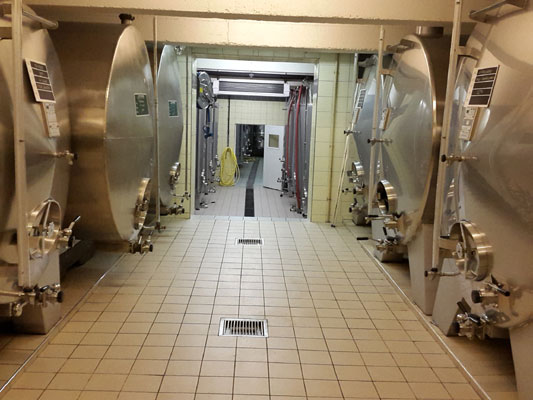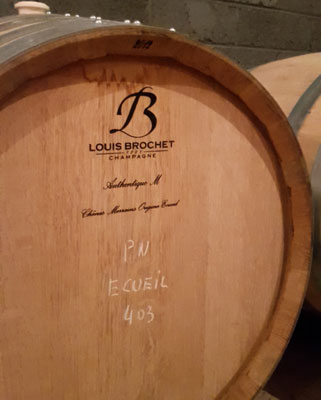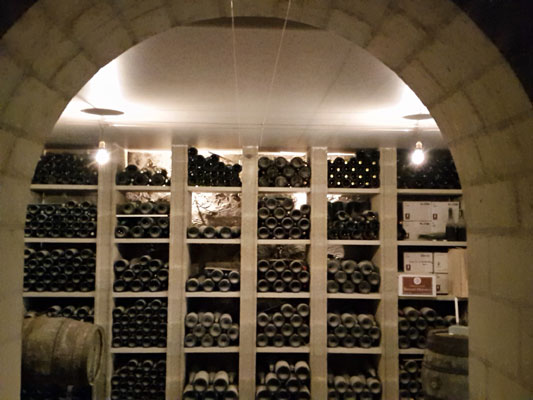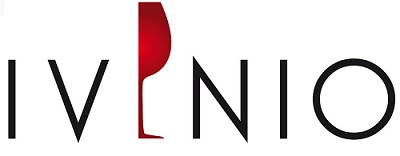
Visit to Champagne Louis Brochet
First out in 2015, in the series of our wineries, is Champagne Louis Brochet. Louis Brochet is a totally independent family property. Brochet not only grows their own grapes – they also produce their own wine, bottle themselves and then commercialize the finalized wine. In many wine regions, this appears to be obvious, but in Champagne, many winegrowers are just wine growers who sell their grapes to the larger wineries which then produce the wines.

Cuverie Louis Brochet
 Louis Brochet is located on the outskirts of the Écueil village, just south of Reims. The landscape is typical of Champagne with low vinecovered hills – perfectly aligned vines which occupy the visibility all the way to the horizon. The entrance to Brochet is also typical with a narrow port showing the way through the sand beige-colored wall that surrounds the winery's main building. The hospitality is warm and you feel immediately welcome.
Louis Brochet is located on the outskirts of the Écueil village, just south of Reims. The landscape is typical of Champagne with low vinecovered hills – perfectly aligned vines which occupy the visibility all the way to the horizon. The entrance to Brochet is also typical with a narrow port showing the way through the sand beige-colored wall that surrounds the winery's main building. The hospitality is warm and you feel immediately welcome.
Louis Brochet's history dates back to the mid 1800s when Marie Arsène Brochet said to have marked her best vines with a cross. Hélène Brochet explains to us that at that time, the vines in Champagne were not planted in rows, but you could go around them to inspect them from all angles. The cut branches on the vines which had received a cross for three consecutive years, were used to replant strong and robust vines. This was the beginning of the typical "Pinot noir d'Ecueil". It works namely excellently to cultivate new vines by just putting cut branches directly into the soil. The vine branches take root and create new vines.
Dégorgement: the deposit in the bottle is
chilled down at the neck. This creates an ice cube
which is removed and replaced with expedition liqueur.
The vineyard is today run by the sisters and brothers Louis and Hélène Brochet, whose great-grandfather, also named Louis (Marie Arsène's son) has given name to the winery. The vineyard was until recently called Hervieux-Brochet, but was then renamed to the simpificated Louis Brochet. Louis is a graduated oenologist and manages the wine production. Hélène is responsible for the commercial and administrative tasks. Hélène is also our everyday contact person and she controls our regular deliveries of wine.
The Brochet vineyards located in the Écueil village surroundings on the "Montagne de Reims 1er Cru" areas. Mainly Pinot Noir grapes are cultivated, but there is also Chardonnay and Pinot Meunier, since all three grape varieties are part of the wine compositions. The wines are not officially organic, but the fertilizer and pesticides used are for organic farming.
 The backbone of Brochet's champagne segment are 3 different 1er Cru Champagnes from the three most common segments; an Extra-brut, a Brut and a Demi-sec. All three are primarily made of Pinot Noir (78%), but also Chardonnay (15%) and Pinot Meunier (7%). all 3 of the wines contain 50% of reserve wine. Reserve wine is different wines from different vintages blended with wines from this year's harvest. This is what makes it possible to obtain an almost identical taste regardless of the vintage you drink. The standard segment is commercialized only four years after the harvest, when the legislation only requires 15 months of storage after having started the second fermentation (the fermentation that makes the bubbles!).
The backbone of Brochet's champagne segment are 3 different 1er Cru Champagnes from the three most common segments; an Extra-brut, a Brut and a Demi-sec. All three are primarily made of Pinot Noir (78%), but also Chardonnay (15%) and Pinot Meunier (7%). all 3 of the wines contain 50% of reserve wine. Reserve wine is different wines from different vintages blended with wines from this year's harvest. This is what makes it possible to obtain an almost identical taste regardless of the vintage you drink. The standard segment is commercialized only four years after the harvest, when the legislation only requires 15 months of storage after having started the second fermentation (the fermentation that makes the bubbles!).
We first try the Extra-brut which has a low dosage of sugar. The wine has a fruity aroma of apple and pear with hints of honey and vanilla. The taste is dry with good and pleasant acidity. A Champagne for connoisseurs who want a dry, subtle champagne that goes well mainly together with oysters and seafood.
Oakbarrel for the reserve wine
We continue with the "Brut" variant which is the most universal and which actually fits as a beverage together with anything. A fruity aromas of apple and pear also here. The taste is also very fruity but "winy" from the couple of years of long aging. Good concentration and with great personality. Some toasty hints and above all very well balanced. Perfect as an aperitif, through a whole meal, it also has enough of fruitiness (not so dry) to be served to a sweet dessert at the end of the meal.
The Demi-sec is the same wine as for the other versions, it's just the sweetness that is higher since it contains a higher dose of sweet "expedition liqueur". Demi-sec is suitable for those who want a little sweeter aperitif or mainly, for those looking for a sweet and fruity wine to drink together with a dessert with fruit or chocolate.
Brochet also produces a Millésime-Champagne the years considered to be good. The years when the harvest hasn't been totally convincing, the Millésime variant is skipped rather then to compromise on the wine quality. Millésime is produced from Pinot Noir and Chardonnay grape varieties and may be stored much longer than the three years required by law when talking about millesimated Champagne. We taste a Millésime 2006 which is already in its ninth year and is still for sale. The bubbles are small and rises through the glass in a homogeneous string, landing in a cloud of foam on the surface. The aroma is complex with hints of dried fruit, ripe apricots, pears, citrus and white flowers. The taste is fruity and round with great elegance and length. A great champagne.
 As if to prove that champagne is eminently possible to store when it is well made, we continue tasting the HBH 1997. HBH means Henri Brochet – Hervieux and is a cuvée which is only launched those years considered to be exceptional. The wine is made of equal parts of Pinot Noir and Chardonnay from the best-exposed fields. The wine is stored in wooden beams (vieillissement sur lattes) for at least 10 years before it goes on sale. A deeper yellow color, very elegant foam with fine bubbles. HBH has in recent years been made -96, -97, -99 and 2002. What is typical for the 1997, is the freshness and the great elegance.
As if to prove that champagne is eminently possible to store when it is well made, we continue tasting the HBH 1997. HBH means Henri Brochet – Hervieux and is a cuvée which is only launched those years considered to be exceptional. The wine is made of equal parts of Pinot Noir and Chardonnay from the best-exposed fields. The wine is stored in wooden beams (vieillissement sur lattes) for at least 10 years before it goes on sale. A deeper yellow color, very elegant foam with fine bubbles. HBH has in recent years been made -96, -97, -99 and 2002. What is typical for the 1997, is the freshness and the great elegance.
Longterm storage cellar at Louis Brochet
Last but not least, we taste the rosé variant produced in the same proportions as the base segment; 78% Pinot Noir, 15% Chardonnay and 7% Pinot Meunier. The red wine from Pinot noir is mixed with the white wine in different proportions, depending on the vintage. The rosé Champagne is a "meatier" wine with hints of red fruit, mainly cherries and raspberries. The wine is perfect as an aperitif, but also as a festive alternative together with food at the table.
 Just as Pol Roger deemed to have been Churchill's favorite champagne has also Louis Brochet been a celebrity favorite. Hergé who designed the Tintin cartoons was a big fan of champagne and like many other Belgians, he often came to Champagne to fill up the baggage with his favorite beverage. Hergé loved Brochet-Hervieux, as the champagne house was called at that time and he often came visiting the property. Hergé has actually, as a tribute to his favorite champagne, designed Captain Haddock on page 55 of "Destination Moon", striving with an errant champagne bottle from Brochet-Hervieux. The cork finally goes off and ends up in the throat of Captain Haddock …
Just as Pol Roger deemed to have been Churchill's favorite champagne has also Louis Brochet been a celebrity favorite. Hergé who designed the Tintin cartoons was a big fan of champagne and like many other Belgians, he often came to Champagne to fill up the baggage with his favorite beverage. Hergé loved Brochet-Hervieux, as the champagne house was called at that time and he often came visiting the property. Hergé has actually, as a tribute to his favorite champagne, designed Captain Haddock on page 55 of "Destination Moon", striving with an errant champagne bottle from Brochet-Hervieux. The cork finally goes off and ends up in the throat of Captain Haddock …
From our side, we do like Hergé and ensure that our inventory is filled and say thank you for a nice visit in Champagne!






